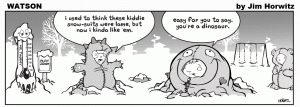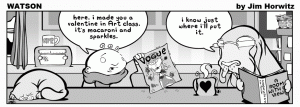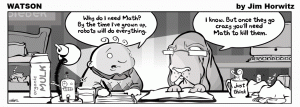 Jim Horwitz, creator of the non-IBM “Watson.”
Jim Horwitz, creator of the non-IBM “Watson.”
Jim Horwitz is the creator of the comic strip “Watson,” a strip about a talking dog who reads the newspaper and a little boy who loves texting. The premise of the strip is familiar, but Horwitz’ treatment of it is anything but common. He has lots to say about using the comic strip panel in strange new ways, and what may lie in store for comic strips on the Internet in the wake of the new digital revolution.
Hey Jim, thanks for speaking with me today. How did you get started drawing your comic “Watson?”
I’ve been drawing comics for many years. I drew several different daily strips for the student papers in college and in graduate school, and self-syndicated a strip to college papers, nationally, for several years in-between. When I was 22, Universal Press Syndicate took an interest in one of the strips I was drawing, and we were in communication about it for 6 months. Although they decided to pass on it, I think that early experience was good for me. I think those early talks with Universal helped me address the importance of connecting with an audience. At the time, drawing a strip about a talking dog was the furthest thing from my mind, probably the last thing I would’ve ever wanted to do. Compared to “Watson” my early strips were very weird. Now that I know what having a dog is really like, drawing a mainstream comic strip about a dog seems much more appealing. And, the fact that (the real) Watson is so smart makes coming up with story ideas much easier. He’s the brains of the operation.
How would you describe the humor of the strip?
“Watson” is a one-panel strip with reoccurring characters. It’s a little different from most strips that run in the paper, because it’s neither gag-based nor solely character based; it’s right in the middle. You get a general feeling for who the characters are based on repetition, and hone in on the humor based on the strength of the gags or how the jokes reflect on the characters’ personalities. The format does have its limitations and challenges, but it’s the one that seems most “true” to me. I’ve never been comfortable drawing multi-panel strips. I’m fine with drawing and fine with writing, but for whatever reason I just have this way of thinking that takes the form of isolated moments, rather than traditional, multi-panel set-ups. The idea that the opening panels in a comic strip are there to help “set up” the joke seems disingenuous. I know that’s how most comic strips are supposed to work, but it’s a way of thinking that just seems very foreign to me. I could probably learn to write that way if I practiced, but I think that’s probably the last thing the world needs – another standard strip about dogs.
What do you think the Internet has in store for the future of comics, and how does “Watson” fit into that?
While syndicates still control comic strips in the newspaper, I think the model of the syndicate as a financial intermediary between the artist and his or her readership is broken. The Internet is cheaper, faster, and more accessible to readers than any one paper. On the Internet, there’s really no difference between the distribution power of the syndicates and that of this new generation of web-cartoonists. If anything, web- cartoonists have more freedom because they can control their own sites, they don’t have to divide up their profits, and they’re not limited to the kind of specific, family-friendly humor that syndicates have traditionally marketed. At this point, with things in the comic strip business being as they are, I think “safe” is dead. No one’s interested in seeing the same old thing churned out; even less so if it’s in a newspaper. I think the humor in “Watson” is a bit unusual, and I think that’s a good thing. The one good thing about syndicates is that they provided a measure of quality control by assessing the writing and artwork before putting a comic strip out into the world. I think the difference now is that, rather than going to one printed comics page or syndicate website, readers may have to look harder to find that next great strip online. The downside for syndicates is that once comic strips are online, no one will want to pay to read them again. At that point, the only way for syndicates to make money will be to sell mugs, books, or shirts, which is a part of the current model. In the past, the one power that syndicates had was the power over distribution. They were the only ones who could get your comic strip into newspapers, and that was the ONLY way people could read it. But because the old model of distribution will die doesn’t mean comics will die. If anything, they’ll now have the freedom to grow and change. Over time, I suspect most comics will become more specialized, with a smaller mainstream audience and more selective readership. Rather then there being one or two multi-millionaire cartoonists, I think now there will probably be a couple hundred thousand-bucks-a-month cartoonists. It’s nothing any one company or business can control. Like the Internet, it’s in the hands of readers and artists. Maybe that’s the way it should be.
What comic or cartoon has been your greatest influence?
While I don’t have any one “greatest” comic strip influence, there are things about certain comics that have been influential. I’ve always been an admirer of any cartoonist who can create a new world, with new voices, using a whole new kind of line. It’s not just one thing, or facet, in isolation; it’s the whole strip. It wasn’t as important to me when I was younger, but it’s certainly become more important as I’ve worked in the field longer. I admire the courage of artists who are able to stay true to their own voices and find success staying true to that vision. I think there are many artists and cartoonists like this out in the world, but, because of the problem of exposure, we only get to see the ones whose voices instinctively align with what’s marketable or successful. It may sound silly given the look of my strip, but visually I enjoy strips that are very clean and simple, as if the cartoonist knew exactly what was needed, and drew only the essentials. I think that’s the mark of a good artist. Clarity and precision. It’s the thing I look for in all art.
How do you feel the content of humor has and will change in the future?
Listen, I love comic strips just as much as the next person, but I will say there’s a pretty definite disconnect between the content of most daily comic strips and what’s going on in the world. I think if you were to look at seventy-percent of the comics on the comic page, you wouldn’t be able to tell if they were comics that ran in 1985 or 2011, and I think that’s significant. I think humor is changing in the same way that people’s experience of the world is changing; funny will always be funny, but to be really funny something needs to be smart, too. I’m not sure if it’s any one thing an artist can do consciously to position him-/herself ahead of the curve. I think a lot of artists and writers will continue to do what they know and feel and are good at, and, low and behold, one or two of them will just happen to be doing the one brilliant, funny thing that the world didn’t know it was missing, but needed. As far as I’m concerned that’s always the best kind of art.
Thanks for talking with me Jim.
It was lots of fun. Thanks for having me.
You can read Watson at:
And join him on Facebook at:
http://www.facebook.com/pages/Watson/146883455358391?ref=ts




